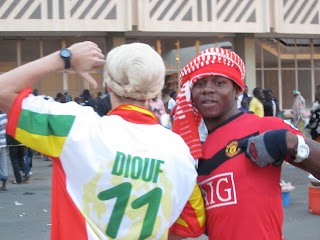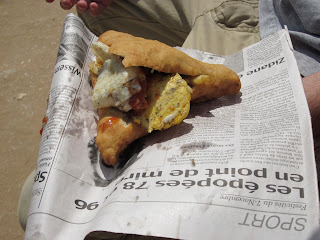March 26 was the most highly anticipated day of my semester in Dakar. It was the day of the African Cup of Nations qualifier between Senegal and Cameroon. For Senegal, being arguably the best team in Africa at the moment, a victory would could establish themselves as such while a loss would perpetuate the recent trend of disappoint and short-comings that have plagued the side since their successful 2002 World Cup campaign.
10h30: I went to the nearby Radisson Blu hotel, where I had a hunch the Cameroon team was staying. (Watching the near endless news coverage of the teams and the match, I managed to recognize the interior of the hotel where they showed the Cameroon team hanging out.) On my way a couple of my soccer buds from the neighborhood tagged along to see if I was right.
10h50: Indeed I was correct. I saw the team bus and confirmed my theory with one of many security guards on the premise, though I was unsuccessful in buttering him up enough to let me into the hotel. After a walk around the gated hotel, we snuck onto the roof of the nearby shopping complex to catch a view at the backside of the hotel where the pool and dining are is. I like to think I saw Samuel Eto’o eating breakfast, though it could have been anybody wearing a green shirt and a hat (that was somewhat Eto’o-esque from what I’ve seen, so who knows).
11h45: I convinced my brother, Munir (17) to eat lunch early and we soon headed off to the stadium. I bought him a ticket so he was my companion for the day (and night).
12h20: Waiting for the 23 bus to Parcelles (a neighborhood near the stadium named, like many other significant Dakar landmarks, after the first president of Senegal).
12h45: On the bus en route to the stadium. Munir has informed me he has no idea where were going so I am now the navigator in charge of determining when we get off.

13h30: Trying to remember from my last visit to the stadium, I make the call. We get off, cross the street and
voila! Stade Leopold Sedhar Senghor, we had arrived.
13h50: The area around the stadium is already packed with people trying to get in. Senegalese inefficiency at its finest ensured us a 2 hour wait before we could get into the stadium, which was already half full, two and half hours before kickoff. The wait was made somewhat easier by the characteristic music that follows every sporting event here and a coffee promotion where they were giving away packets of spiced Nescafe.

15h30: We finally wrestle our way to an open spot in the concrete stands and begin the long wait until game time, entertained by the supporters groups already in full swing, dancing, clapping, drumming and singing.
17h10: The teams take the field for warm-ups, the roar of the crowd upon Samuel Eto’o’s entrance actually rivaled the one for the whole Senegalese team, however there was no doubt where their loyalties lay.

18h00: Kickoff was on time and the game was finally underway. The stadium was completely full and under the hot African sun the supporters were giving their Lions of Teranga (the nickname of the Senegalese national team) their all. The first half was somewhat disappointing as neither team was able to find a rhythm and really scoring chances were few. The few moments of excitement came whenever Samuel Eto’o was on the ball and when the ball was passed back to the Senegalese keeper, who had a dangerous habit of dribbling around on coming Cameroonian forwards. The second half was much better, with each team having their own spells, although Senegal was showing why they were the better team (except for some typically Senegalese defensive blunders that almost cost them dearly). Eto’o continued to shine, though without much help, chances were few and far between with most of his impressive work being done away from goal, with one exception that nearly opened the scoring. As the game went on, Senegal’s pressure increased, but the breakthrough was still absent, much to the frustration of the home crowd (which was growing as the minutes drained). Due to a large number of stoppages during the second half, there must have been at least five minutes of extra time (though there is no way of knowing for sure without a clock, scoreboard, announcer, or jumbotron). It seemed as if this were going to be another disappointment for Senegal as they were unable to make good with their opportunities.

All that was forgotten, however, once Demba Ba hammered in a low cross from the left flank to surely give Senegal the three points. The entire stadium, the stands, everyone on the field went nuts. I can’t really describe much more because the entire place was in a state of chaos, which lasted the last minute of added time and was reignited by the final whistle.
Everyone was screaming, hugging, jumping, singing, just about every celebratory action was being carried out in one way or another in that stadium. We noticed people jumping on to the field so Munir and I battered our way to the front row and without a second thought I pushed the people in front of me aside and jumped the 5-meter drop onto the field, finishing with a not-so graceful roll.

Munir had no choice but to follow suite and within seconds we were racing across the field yelling and celebrating with the other brave fans who made the jump and bypassed the security and various members of the armed forces. We soon found ourselves in a mob that was shepherded out of the stadium and into the streets where the celebration continued. It was so crowded cars couldn’t move, instead they mounted as dancefloors, booming music, along with every shop that had speakers. We ran, danced, sang, and cheered our way from the stadium, as gradually the group got smaller and smaller. We were then passed by the familiar Cameroon team bus, full of sad faces, before hopping on a
kaar rapide (public van transportation) and heading home to share the story with the fam.

 The way it works is we start with a few whole, skinned, lambs with everything else still intact. In the afternoon we clean break down the lamb into quarters and selections of the other lamb parts (liver, heart, head, intestines, lungs etc.) all of which is cooked, bought, and eaten. The tools of Dibiterie are a machete for breaking down the whole lamb, a smaller knife to slice onions, a large metal spoon to pull the meat off the grill and a piece of concrete framing steel used like a spatula. The quarters are stored in a freezer with whole chickens, pigeons, and the livers and hearts. All of these are cut up and cooked upon ordering over an open flame with sliced onions.
The way it works is we start with a few whole, skinned, lambs with everything else still intact. In the afternoon we clean break down the lamb into quarters and selections of the other lamb parts (liver, heart, head, intestines, lungs etc.) all of which is cooked, bought, and eaten. The tools of Dibiterie are a machete for breaking down the whole lamb, a smaller knife to slice onions, a large metal spoon to pull the meat off the grill and a piece of concrete framing steel used like a spatula. The quarters are stored in a freezer with whole chickens, pigeons, and the livers and hearts. All of these are cut up and cooked upon ordering over an open flame with sliced onions.















































